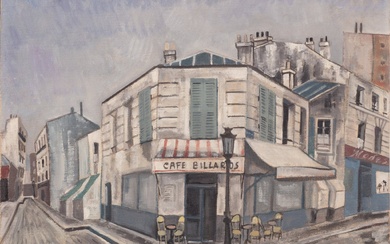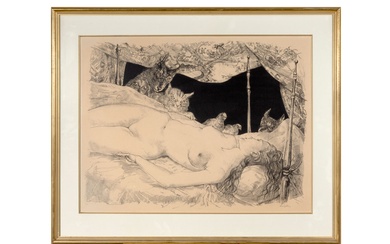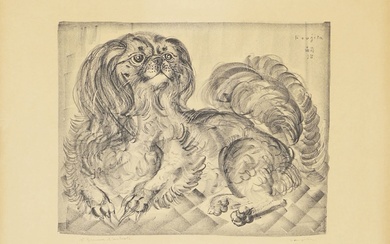Leonard Tsuguharu Foujita, (1886-1968)
La mère et l'enfant
La mère et l'enfant
signed 'Foujita' (lower centre); signed, inscribed and numbered '5 F la mère et l'enfant Foujita' (on the stretcher, verso)
oil and brush and ink on linen
35.3 x 27.3cm (13 7/8 x 10 3/4in).
Painted in 1958
The authenticity of this work has kindly been confirmed by Madame Sylvie Buisson.
Provenance
Galerie Paul Pétridès, Paris.
Private collection, France (acquired from the above, 1958).
Thence by descent.
Acquired from the above by the present owner.
Exhibited
Les Arques, Musée Zadkine, Foujita-Zadkine, Un centenaire, une amitié, L'Ecole de Paris en Quercy, 18 May - 15 September 2013.
Moscow, The Pushkin State Museum of Fine Arts, 'Les années folles' de Montparnasse. Peintures et arts graphiques de Jules Pascin et Léonard Foujita dans les collections publiques et privées Françaises, Suisses, Belges et Russes, 29 September - 29 November 2015, no. 93.
Literature
S. Buisson, T. L. Foujita, Inédits, Turin, 2007, no. C58.099.H (illustrated p. 321, incorrectly catalogued as 'inscribed no. 27').
S. Buisson, Foujita et ses amis du Montparnasse, (exh. cat.), Paris, 2010 (illustrated p. 125).
La mère et l'enfant was executed in 1958, a time of great change for Tsuguharu Foujita who became a French national, changed his first name to Léonard and was converting to Catholicism. This 'Europeanism' followed his return to France in 1950 after a long exile of almost twenty years, a few of which he was forced to spend in Japan as a war artist for the government. Finally able to come back, Foujita quickly renewed and embraced his old life in Paris. He settled once again in his beloved Montparnasse with his new wife Kimiyo and, aided by the dealer Paul Pétridès, who wasted no time in promoting the artist's work, quickly regained the success he had known during les années folles of the 1920s. From 1950 onwards, Pétridès held exclusive exhibitions for Foujita every two years until 1964.
In his quest to embrace Christianity, Foujita met with Pope Benedict XV who commissioned a portrait and opened the doors of the Vatican where he spent some time. This had a profound impact on the artist, who, among other things, was amazed by the works by Giotto and the murals of the Cappella Niccolina. From then on, and as a direct result of these life changes, Foujita's paintings increasingly combined religious or historical significance with an extraordinary sensibility for the feminine countenance. And, although this led to major new sources of inspiration, Foujita never let go of his first artistic instruction in Japan and his paintings kept the distinctively refined dexterity which first brought him fame.
The present work belongs to this mature period of exploration into the religious and mystical and is reminiscent of compositions from medieval paintings. The story of the mother and child is a powerful narrative which has been frequently explored by Foujita. Children hold a very special place in Asian cultures and as Robert Rey explains, 'In Asia, every childhood is sacred... it is by instinct that Foujita transforms the children of France into fairies. Consider what becomes of Cosette from Victor Hugo's Les Misérables, a book the artist perhaps never read... a little girl unburdened by the slightest misery' (S. Buisson, Foujita et ses amis du Montparnasse, (exh. cat.), Paris, 2010, p. 134). It is also perhaps as a tribute to his own childhood that Foujita revisited the subject of mother and child time and again, as a reminder of the tragic loss of his mother when he was aged just eight years old.
La mère et l'enfant brilliantly captures the multiple influences Foujita absorbed, from the Renaissance period of Madonna and child paintings, the Japanese calligraphy heritage, as well as his own interpretation of Modern European art. The surface is typical with both sitters depicted with pearly-white flesh set against a flat background, describing a scene of deep tenderness between a mother and her child. The child's extremely smooth face is adorned with fluttery blue eyes gazing in the distance and small delicate, doll-like features. The mother stares straight at the viewer with a solemn intensity and an enigmatic smile. Poised between the abundance of the ornate tapestry-like background and the simplicity of the nearly nude sitters, Foujita demonstrates here his ability to balance backdrop and subject.
Executed on a small scale, like a small devotional icon, the work pre-empts the grand masterpiece that is the Foujita Chapel which was built in 1966. Perhaps in a bid to buy his way into paradise, the Chapel is also testament to Foujita's intention to leave a legacy as the great artist who united the East and the West, an impression reflected in his own words: 'I wondered why my predecessors had only come to measure themselves against Europeans with the intention of returning to occupy important positions in Japan. I on the other hand was determined to lead a serious struggle on the continent, to compete on the real battlefield, even if it meant rejecting everything I had learned up until then' (L. Foujita quoted in S. Buisson, ibid, 2010, p. 54)
View it on
Sale price
Time, Location
Auction House
La mère et l'enfant
La mère et l'enfant
signed 'Foujita' (lower centre); signed, inscribed and numbered '5 F la mère et l'enfant Foujita' (on the stretcher, verso)
oil and brush and ink on linen
35.3 x 27.3cm (13 7/8 x 10 3/4in).
Painted in 1958
The authenticity of this work has kindly been confirmed by Madame Sylvie Buisson.
Provenance
Galerie Paul Pétridès, Paris.
Private collection, France (acquired from the above, 1958).
Thence by descent.
Acquired from the above by the present owner.
Exhibited
Les Arques, Musée Zadkine, Foujita-Zadkine, Un centenaire, une amitié, L'Ecole de Paris en Quercy, 18 May - 15 September 2013.
Moscow, The Pushkin State Museum of Fine Arts, 'Les années folles' de Montparnasse. Peintures et arts graphiques de Jules Pascin et Léonard Foujita dans les collections publiques et privées Françaises, Suisses, Belges et Russes, 29 September - 29 November 2015, no. 93.
Literature
S. Buisson, T. L. Foujita, Inédits, Turin, 2007, no. C58.099.H (illustrated p. 321, incorrectly catalogued as 'inscribed no. 27').
S. Buisson, Foujita et ses amis du Montparnasse, (exh. cat.), Paris, 2010 (illustrated p. 125).
La mère et l'enfant was executed in 1958, a time of great change for Tsuguharu Foujita who became a French national, changed his first name to Léonard and was converting to Catholicism. This 'Europeanism' followed his return to France in 1950 after a long exile of almost twenty years, a few of which he was forced to spend in Japan as a war artist for the government. Finally able to come back, Foujita quickly renewed and embraced his old life in Paris. He settled once again in his beloved Montparnasse with his new wife Kimiyo and, aided by the dealer Paul Pétridès, who wasted no time in promoting the artist's work, quickly regained the success he had known during les années folles of the 1920s. From 1950 onwards, Pétridès held exclusive exhibitions for Foujita every two years until 1964.
In his quest to embrace Christianity, Foujita met with Pope Benedict XV who commissioned a portrait and opened the doors of the Vatican where he spent some time. This had a profound impact on the artist, who, among other things, was amazed by the works by Giotto and the murals of the Cappella Niccolina. From then on, and as a direct result of these life changes, Foujita's paintings increasingly combined religious or historical significance with an extraordinary sensibility for the feminine countenance. And, although this led to major new sources of inspiration, Foujita never let go of his first artistic instruction in Japan and his paintings kept the distinctively refined dexterity which first brought him fame.
The present work belongs to this mature period of exploration into the religious and mystical and is reminiscent of compositions from medieval paintings. The story of the mother and child is a powerful narrative which has been frequently explored by Foujita. Children hold a very special place in Asian cultures and as Robert Rey explains, 'In Asia, every childhood is sacred... it is by instinct that Foujita transforms the children of France into fairies. Consider what becomes of Cosette from Victor Hugo's Les Misérables, a book the artist perhaps never read... a little girl unburdened by the slightest misery' (S. Buisson, Foujita et ses amis du Montparnasse, (exh. cat.), Paris, 2010, p. 134). It is also perhaps as a tribute to his own childhood that Foujita revisited the subject of mother and child time and again, as a reminder of the tragic loss of his mother when he was aged just eight years old.
La mère et l'enfant brilliantly captures the multiple influences Foujita absorbed, from the Renaissance period of Madonna and child paintings, the Japanese calligraphy heritage, as well as his own interpretation of Modern European art. The surface is typical with both sitters depicted with pearly-white flesh set against a flat background, describing a scene of deep tenderness between a mother and her child. The child's extremely smooth face is adorned with fluttery blue eyes gazing in the distance and small delicate, doll-like features. The mother stares straight at the viewer with a solemn intensity and an enigmatic smile. Poised between the abundance of the ornate tapestry-like background and the simplicity of the nearly nude sitters, Foujita demonstrates here his ability to balance backdrop and subject.
Executed on a small scale, like a small devotional icon, the work pre-empts the grand masterpiece that is the Foujita Chapel which was built in 1966. Perhaps in a bid to buy his way into paradise, the Chapel is also testament to Foujita's intention to leave a legacy as the great artist who united the East and the West, an impression reflected in his own words: 'I wondered why my predecessors had only come to measure themselves against Europeans with the intention of returning to occupy important positions in Japan. I on the other hand was determined to lead a serious struggle on the continent, to compete on the real battlefield, even if it meant rejecting everything I had learned up until then' (L. Foujita quoted in S. Buisson, ibid, 2010, p. 54)







